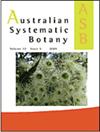利用跨学科方法深入了解亲缘关系密切的桉树的物种形成和物种划界
IF 1.6
3区 生物学
Q4 EVOLUTIONARY BIOLOGY
引用次数: 6
摘要
摘要形态是进化生物学的核心过程,也是地球上生命多样性的原因。尽管在过去的150年里,进化研究取得了很大进展,但理解物种形成的许多方面仍然是一个挑战。在这篇综述中,我专注于使用跨学科的方法来研究一组亲缘关系密切的桉树的物种形成和物种划界,这些桉树被称为绿灰桉树(桉树亚属桉树科桉树)。绿色灰烬包括肥沃土壤上的高大树木(例如世界上最高的被子植物e.regnans),以及低营养土壤上的中等树木和木槌。先前基于全基因组扫描的系统发育和种群遗传学分析表明,绿色灰烬中的物种边界并不总是与基于形态学的分类一致,并且有证据表明基因在谱系之间流动。基因组分析还表明,绿灰处于不同的物种形成阶段,一些物种在基因上高度分化,而另一些物种则处于物种形成连续体的早期阶段。之前的一项普通花园研究表明,幼苗性状的种间差异显著,大多数物种的叶片宽度等性状在资源处理中具有高度可塑性。总的来说,这一综合表明,结合系统发育学、种群基因组学和普通花园实验的跨学科方法可以深入了解绿灰桉树的物种形成和物种划界。这种方法可能有助于了解桉树中其他近亲物种以及其他生物群的进化史。本文章由计算机程序翻译,如有差异,请以英文原文为准。
Insights into speciation and species delimitation of closely related eucalypts using an interdisciplinary approach
Abstract. Speciation is a central process in evolutionary biology and is responsible for the diversity of life on Earth. Although there has been much progress in evolutionary research over the past 150 years, understanding the many facets of speciation remains a challenge. In this synthesis, I focus on the use of an interdisciplinary approach to examine speciation and species delimitation in a group of closely related eucalypts called the green ashes (Eucalyptus subgenus Eucalyptus section Eucalyptus). The green ashes comprise tall trees on fertile soils (e.g. the tallest angiosperm in the world, E. regnans), as well as medium trees and mallees on low-nutrient soils. Previous phylogenetic and population-genetics analyses based on genome-wide scans showed that species boundaries in the green ashes are not always consistent with classifications based on morphology and there was evidence of gene flow across lineages. Genomic analyses also suggested that the green ashes were at varying stages of speciation, with some species being highly genetically differentiated, whereas others were at earlier stages on the speciation continuum. A previous common garden study showed that inter-specific differences in seedling traits were significant, with traits such as leaf width being highly plastic across resource treatments for most species. Overall, this synthesis demonstrated that an interdisciplinary approach incorporating phylogenomics, population genomics and a common garden experiment can provide insights into speciation and species delimitation in the green ash eucalypts. Such an approach may be useful in understanding the evolutionary history of other closely related species in Eucalyptus, as well as other groups of organisms.
求助全文
通过发布文献求助,成功后即可免费获取论文全文。
去求助
来源期刊

Australian Systematic Botany
生物-进化生物学
CiteScore
3.10
自引率
12.50%
发文量
12
审稿时长
>12 weeks
期刊介绍:
Australian Systematic Botany is an international journal devoted to the systematics, taxonomy, and related aspects of biogeography and evolution of all algae, fungi and plants, including fossils. Descriptive taxonomic papers should normally constitute a comprehensive treatment of a group. Short papers on individual species and nomenclatural papers must contain significant new information of broader interest to be considered. The prestigious L.A.S. Johnson Review Series is published. Other review articles will also be considered. All papers are peer reviewed.
Australian Systematic Botany is published with the endorsement of the Commonwealth Scientific and Industrial Research Organisation (CSIRO) and the Australian Academy of Science.
 求助内容:
求助内容: 应助结果提醒方式:
应助结果提醒方式:


